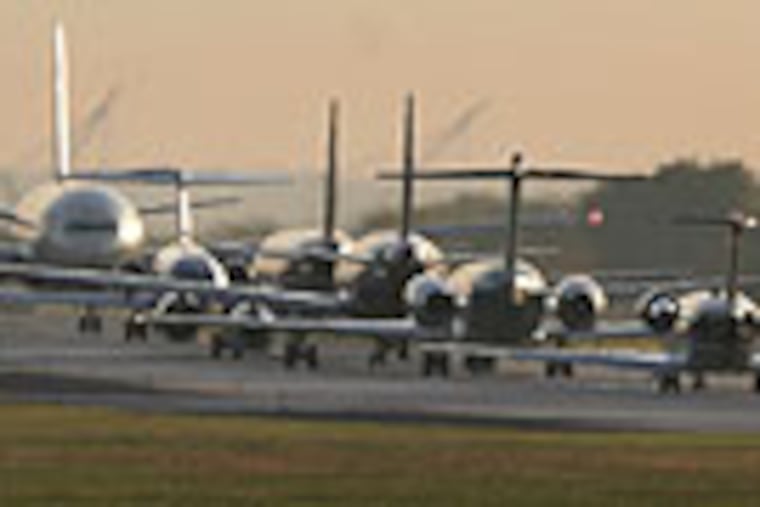A look at the upgrades planned for Terminal F
Philadelphia International Airport is set for $535 million in renovations, including a $135 million face-lift to commuter Terminal F. When the terminal, designed for smaller jets and turboprops, opened in 2001, US Airways Group Inc. flew 158 daily Express round-trips out of Terminal F. Today the airline has 293 daily Express flights here, most of them out of Terminal F, but some using other airport gates.

Philadelphia International Airport is set for $535 million in renovations, including a $135 million face-lift to commuter Terminal F.
When the terminal, designed for smaller jets and turboprops, opened in 2001, US Airways Group Inc. flew 158 daily Express round-trips out of Terminal F. Today the airline has 293 daily Express flights here, most of them out of Terminal F, but some using other airport gates.
One-fifth of the airport's 30.6 million passengers last year started or ended trips there. This project is unrelated to a long-term airport expansion under consideration by the Federal Aviation Administration.
"Terminal F, in its existing condition, is not what our passengers deserve," said airport chief executive officer Mark Gale. "Improvements are needed to deal with the amount, and type, of traffic coming through."
City Council is expected to vote next week to authorize the sale of airport revenue bonds for $535 million in capital projects, and to refinance $70 million in existing debt at lower interest rates. The project will go out to bid in the fall, and construction could begin before the end of the year, Gale said.
The expansion will be completed in 2013 and financed by fees charged to airlines.
The Terminal F redesign calls for enlarging the center "hub" where three concourses intersect, doubling the number of restaurants and retail shops, and adding passenger seating.
Walls will be pushed out on Concourse 3 to expand the passenger waiting area and accommodate regional jets that a decade ago carried 50 passengers but today can shuttle 72 and 90 passengers.
A new baggage-claim building will be constructed under the F parking garage and next to other terminal baggage-claim facilities, on the arrivals road.
The walkway that connects Terminals E and F will be put behind security.
Passengers, for the first time, will be able to walk the length of the airport, from Terminal F to International Terminal A-West, and go through security only once.
The public should welcome relocation of the bag-claim carousels. Terminal F has confused passengers since its opening because the bag-claim is next to the ticket counter, on the departures road - not on the arrivals road where families expect to meet travelers.
"We have had instances where passengers have been unable to connect with the folks picking them up," Gale said. "A passenger will stand on the curb outside baggage claim, and the person picking them up will call, 'Where are you? I'm coming down the arrivals side,' " Gale said.
"We have passengers today, and employees, who grab their bags and run across the street, which is unsafe. We have seen too many close calls where people have almost been hit by vehicles," Gale said. "By moving the baggage claim to the other side, we are giving them a safe path of travel, and a brand-new baggage-claim facility. It's long overdue."
Other improvements in the $535 million include:
Replacing or refurbishing older jet bridges or walkways that connect passengers from terminals to the aircraft.
Upgrading interior signage throughout the airport to help passengers better find their way.
Constructing additional taxiways to make the airfield more efficient, along with taxiway "edging" lighting.
Resurfacing one of the two east-west runways, known as 9 Left-27 Right, that is parallel to the Delaware River and closest to the terminals.
Improving street and exterior signage lighting.
Updating the central utility plant, which houses boilers and chillers for warming and cooling.
Replacing some roofing, air-handler, and air-conditioning equipment.
Renovating restrooms.
Acquiring land to the east and west of the airport for $150 million to enlarge the airfield and add gates in the international terminal.
These improvements are not related to a $5.2 billion airport proposal being considered by the FAA over the next 12 to 15 years.
The long-range FAA plan, which calls for a fifth runway along the Delaware River and possibly a new commuter terminal on the opposite side of the airfield, would "take a long time to build," Gale said. "Meanwhile, we have to operate one of the busiest terminals at the airport."
Enhancements to Terminal F will bring in extra revenue from additional retail concessions. The upgrades will give US Airways, Philadelphia's dominant airline, "better flexibility" to operate jets of various sizes "out of different terminals. That will be an operational advantage," Gale said.
The largest recent expansion project at Philadelphia airport, the ninth-busiest in the country, was the $550 million international Terminal A-West that opened in 2003.
A $350 million overhaul of Terminals D and E, prompted when Southwest Airlines Co. started service here in 2004, brought more shops, new automated baggage sorting and bag-claim areas, additional passenger screening, new gates, and an expanded E Terminal.
"This is a big bond deal, but not the biggest single project that we've done," Gale said, referring to the latest planned construction.